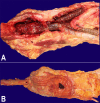Mycotic aneurysm with aortoduodenal fistula
- PMID: 28740836
- PMCID: PMC5507566
- DOI: 10.4322/acr.2017.015
Mycotic aneurysm with aortoduodenal fistula
Abstract
Firstly described in the 19th century by Sir William Osler, the mycotic aneurysm (MA) is a rare entity characterized by an abnormal arterial dilation, which is potentially fatal, and is associated with the infection of the vascular wall. Elderly patients are mostly involved, especially when risk factors like chronic diseases, immunosuppression, neoplasia, and arterial manipulation are associated. The authors report the case of a young male patient diagnosed with an aortic aneurysm of infectious origin in the presence of repeated negative blood cultures. The diagnostic hypothesis was raised when the patient was hospitalized for an inguinal hernia surgery. The diagnosis was confirmed based on imaging findings consistent with mycotic aneurism. The patient was treated with an endovascular prosthesis associated with a long-lasting antibiotic therapy. Five months later, the patient attended the emergency unit presenting an upper digestive hemorrhage and shock, from which he died. The autopsy revealed a huge aneurysm of the abdominal aorta with an aortoduodenal fistula. The histological examination of the arterial wall revealed a marked inflammatory process, extensive destruction of the arterial wall, and the presence of Gram-positive bacteria. This case highlights the atypical presentation of a MA associated with an aortoduodenal fistula. Besides the early age of the patient, no primary arterial disease could be found, and no source of infection was detected.
Keywords: Aneurysm, Infected; Aortic Aneurysm; Fistula.
Conflict of interest statement
Conflict of interest: None
Figures






References
-
- Osler W. The gulstonian lectures, on malignant endocarditis. BMJ. 1885;1(1262):467-70. http://dx.doi.org/10.1136/bmj.1.1262.467. - DOI - PMC - PubMed
-
- Müller BT Wegener OR, Grabitz K, Pillny M, Thomas L, Sandmann W. Mycotic aneurysms of the thoracic and abdominal aorta and iliac arteries: experience with anatomic and extra-anatomic repair in 33 cases. J Vasc Surg. 2001;33(1):106-13. http://dx.doi.org/10.1067/mva.2001.110356. - DOI - PubMed
-
- Bisdas T, Teebken OE. Mycotic or infected aneurysm? Time to change the term. Eur J Vasc Endovasc Surg . 2011;41(4):570- 2. http://dx.doi.org/10.1016/j.ejvs.2010.11.036. - DOI - PubMed
-
- Chan FY, Crawford ES, Coselli JS, Safi HJ, Williams TW Jr. In situ prosthetic graft replacement for mycotic aneurysm of the aorta. Ann Thorac Surg . 1989;47(2):193-203. http://dx.doi.org/10.1016/0003-4975(89)90268-3. - DOI - PubMed
-
- Cinà CS, Arena GO, Fiture AO, Clase CM, Doobay B. Ruptured mycotic thoracoabdominal aortic aneurysms: a report of three cases and a systematic review. J Vasc Surg. 2001;33(4):861-7. http://dx.doi.org/10.1067/mva.2001.111977. - DOI - PubMed
Publication types
LinkOut - more resources
Full Text Sources
Other Literature Sources

